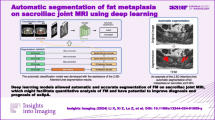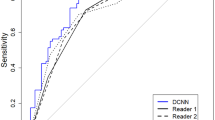Abstract
Ankylosing spondylitis (AS) is a chronic inflammatory disease that causes inflammatory low back pain and may even limit activity. The grading diagnosis of sacroiliitis on imaging plays a central role in diagnosing AS. However, the grading diagnosis of sacroiliitis on computed tomography (CT) images is viewer-dependent and may vary between radiologists and medical institutions. In this study, we aimed to develop a fully automatic method to segment sacroiliac joint (SIJ) and further grading diagnose sacroiliitis associated with AS on CT. We studied 435 CT examinations from patients with AS and control at two hospitals. No-new-UNet (nnU-Net) was used to segment the SIJ, and a 3D convolutional neural network (CNN) was used to grade sacroiliitis with a three-class method, using the grading results of three veteran musculoskeletal radiologists as the ground truth. We defined grades 0–I as class 0, grade II as class 1, and grades III–IV as class 2 according to modified New York criteria. nnU-Net segmentation of SIJ achieved Dice, Jaccard, and relative volume difference (RVD) coefficients of 0.915, 0.851, and 0.040 with the validation set, respectively, and 0.889, 0.812, and 0.098 with the test set, respectively. The areas under the curves (AUCs) of classes 0, 1, and 2 using the 3D CNN were 0.91, 0.80, and 0.96 with the validation set, respectively, and 0.94, 0.82, and 0.93 with the test set, respectively. 3D CNN was superior to the junior and senior radiologists in the grading of class 1 for the validation set and inferior to expert for the test set (P < 0.05). The fully automatic method constructed in this study based on a convolutional neural network could be used for SIJ segmentation and then accurately grading and diagnosis of sacroiliitis associated with AS on CT images, especially for class 0 and class 2. The method for class 1 was less effective but still more accurate than that of the senior radiologist.




Similar content being viewed by others
Data Availability
The datasets generated and analysed during this study are available from the corresponding author on reasonable request.
References
Klavdianou K, Tsiami S, Baraliakos X: New developments in ankylosing spondylitis-status in 2021. Rheumatology (Oxford) 61(9):3876-3878, 2022
van der Linden S, Valkenburg HA, Cats A: Evaluation of diagnostic criteria for ankylosing spondylitis. A proposal for modification of the New York criteria. Arthritis Rheum 27:361–368, 1984
Christiansen AA, Hendricks O, Kuettel D, et al: Limited reliability of radiographic assessment of Sacroiliac joints in patients with suspected early spondyloarthritis. J Rheumatol 44:70-77, 2017
Bakker PA, van den Berg R, Lenczner G, et al: Can we use structural lesions seen on MRI of the sacroiliac joints reliably for the classification of patients according to the ASAS axial spondyloarthritis criteria? data from the DESIR cohort. Ann Rheum Dis 76:392-398, 2017
Diekhoff T, Hermann KG, Greese J, et al: Comparison of MRI with radiography for detecting structural lesions of the sacroiliac joint using CT as standard of reference: results from the SIMACT study. Ann Rheum Dis 76:1502-1508, 2017
Ye L, Liu Y, Xiao Q, et al: Mri compared with low-dose CT scanning in the diagnosis of axial spondyloarthritis. Clin Rheumatol 39:1295-1303, 2020
Maksymowych WP, Lambert RG, Østergaard M, et al: Mri lesions in the sacroiliac joints of patients with spondyloarthritis: an update of definitions and validation by the ASAS MRI Working group. Ann Rheum Dis 78:1550-1558, 2019
Diekhoff T, Greese J, Sieper J, et al: Improved detection of erosions in the sacroiliac joints on MRI with volumetric interpolated breathhold examination (VibE): results from the SIMACT study. Ann Rheum Dis 77:1585-1589, 2018
Deppe D, Hermann K-G, Proft F, et al: CT-like images of the sacroiliac joint generated from MRI using susceptibility-weighted imaging (SWI) in patients with axial spondyloarthritis. RMD Open 7:e001656, 2021
Jans LBO, Chen M, Elewaut D, et al: MRI-based Synthetic CT in the Detection of Structural Lesions in Patients with Suspected Sacroiliitis: Comparison with MRI. Radiology 298:343-349, 2021
Li Y, Xiong Y, Hou B, et al: Comparison of zero echo time MRI with T1‑weighted fast spin echo for the recognition of sacroiliac joint structural lesions using CT as the reference standard. Eur Radiol 326:3963-3973, 2022
Zhang K, Liu C, Zhu Y, et al: Synthetic MRI in the detection and quantitative evaluation of sacroiliac joint lesions in axial spondyloarthritis. Front Immunol 13:1000314, 2022
Lambert RGW, Hermann KGA, Diekhoff T: Low-Dose computed tomography for axial spondyloarthritis: update on use and limitations. Curr Opin Rheumatol 33:326-332, 2021
Poddubnyy D, Diekhoff T, Baraliakos X, et al: Diagnostic evaluation of the sacroiliac joints for axial spondyloarthritis: should MRI replace radiography? Ann Rheum Dis 81:1486-1490, 2022
Diekhoff T, Eshed I, Radny F, et al: Choose wisely: imaging for diagnosis of axial spondyloarthritis. Ann Rheum Dis 81:237-242, 2022
Poddubnyy D, Weineck H, Diekhoff T, et al: Clinical and imaging characteristics of osteitis condensans ilii as compared with axial spondyloarthritis. Rheumatology 59:3798-3806, 2020
Soffer S, Ben-Cohen A, Shimon O, et al: Convolutional neural networks for radiologic images: a radiologist’s guide. Radiology 290:590-606, 2019
Sieper J, Rudwaleit M, Baraliakos X, et al: The Assessment of SpondyloArthritis international Society (ASAS) handbook: a guide to assess spondyloarthritis. Ann Rheum Dis 68(suppl 2):ii1-ii44, 2009
Nils Friedrich Grauhan, Keno Kyrill Bressem, Yves Nicolas Manzoni, et al: Towards Accurate Detection of Axial Spondyloarthritis by Using Deep Learning to Capture Sacroiliac Joints on Plain Radiographs. Research Square, DOI: https://doi.org/10.21203/rs.3.rs-379664/v1, April 6 2021
Proft F, Vahldiek J, Nicolaes J, Tham R, et al: Analysis of the Performance of an Artificial Intelligence Algorithm for the Detection of Radiographic Sacroiliitis in an Independent Cohort of axSpA Patients Including Both Nr-axSpA and r-axSpA [abstract]. Arthritis Rheumatol 74(suppl 9), 2022
Faleiros MC, Junior JRF, Zavala EJR, et al: Pattern recognition of inflammatory sacroiliitis in magnetic resonance imaging. European Congress on Computational Methods in Applied Sciences and Engineering 640–644, 2018
Maksymowych WP, Lambert RG, Østergaard M, et al: MRI lesions in the sacroiliac joints of patients with spondyloarthritis: an update of definitions and validation by the ASAS MRI working group. Ann Rheum Dis 78(11):1550-1558, 2019
Bressem KK, Adams LC, Proft F, et al: Deep Learning Detects Changes Indicative of Axial Spondyloarthritis at MRI of Sacroiliac Joints. Radiology 305(3):655-665, 2022
Tenório APM, Faleiros MC, Junior JRF, et al: A study of MRI-based radiomics biomarkers for sacroiliitis and spondyloarthritis. Int J Comput Assist Radiol Surg 15(10):1737-1748, 2020
Ye L, Miao S, Xiao Q, et al: A predictive clinical-radiomics nomogram for diagnosing of axial spondyloarthritis using MRI and clinical risk factors. Rheumatology (Oxford). 61(4):1440-1447, 2022
Maksymowych WP, Lambert RG, Baraliakos X, et al: Data-driven definitions for active and structural MRI lesions in the sacroiliac joint in spondyloarthritis and their predictive utility. Rheumatology (Oxford) 60(10):4778-4789, 2021
Castro-Zunti R, Park EH, Choi Y, et al: Early Detection of Ankylosing Spondylitis using Texture Features and Statistical Machine Learning, and Deep Learning, With Some Patient Age Analysis. Comput Med Imaging Graph 82:101718, 2020
Shenkman Y, Qutteineh B, Joskowicz L, et al: Automatic detection and diagnosis of sacroiliitis in CT scans as incidental findings. Med Image Anal 57:165-175, 2019
Isensee F, Jaeger PF, Kohl SAA, et al: nnU-Net: a self-configuring method for deep learning-based biomedical image segmentation. Nat methods 18:203-211, 2021
Postacchini R, Trasimeni G, Ripani F, et al: Morphometric anatomical and CT study of the human adult sacroiliac region. Surg Radiol Anat 39:85-94, 2017
Egund N, Jurik AG: Anatomy and histology of the sacroiliac joints. Semin Musculoskelet Radiol 18:332-339, 2014
Funding
The authors are grateful for the financial support from the National Natural Science Foundation of China (grant nos. 82272104) and the Science and Technology Project in the Social Development Field of Zhuhai City, Guangdong Province, China (grant no. ZH22036201210066PWC).
Author information
Authors and Affiliations
Corresponding authors
Ethics declarations
Ethical Approval
This research study was conducted retrospectively from data obtained for clinical purposes. This study was approved by the institutional ethics committee with waiver of informed consent (no. K14-1).
Consent to Participate
Not applicable.
Conflict of Interest
The authors declare no competing interests.
Additional information
Publisher's Note
Springer Nature remains neutral with regard to jurisdictional claims in published maps and institutional affiliations.
Rights and permissions
Springer Nature or its licensor (e.g. a society or other partner) holds exclusive rights to this article under a publishing agreement with the author(s) or other rightsholder(s); author self-archiving of the accepted manuscript version of this article is solely governed by the terms of such publishing agreement and applicable law.
About this article
Cite this article
Zhang, K., Luo, G., Li, W. et al. Automatic Image Segmentation and Grading Diagnosis of Sacroiliitis Associated with AS Using a Deep Convolutional Neural Network on CT Images. J Digit Imaging 36, 2025–2034 (2023). https://doi.org/10.1007/s10278-023-00858-1
Received:
Revised:
Accepted:
Published:
Issue Date:
DOI: https://doi.org/10.1007/s10278-023-00858-1




